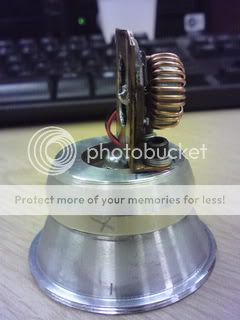I'm not sure it this belongs here, but I will give it a try.
I have manage to reverse engineer the SKU 26106 5xCree 15W driver board from DX and made a schematic. I have also identified the switching regulator on the board, that's AS2001 from Anisem
Having done this, I verified that the regulator also will work fine for 12V battery voltage. The only modification needed is to change the value of the series resistor R4(marked with a circle) from 150ohm to 1Kohm. This is the large 1206 resistor marked "151". this is a zener shunt regulator, and will draw about 50mA with a 150ohm resistor and generate too much heat. It could work still, but I would not recomend it.
The switching reguator is spesified up to 15V, and the other components is not a problem. The only thing is that the input voltage needs på be lower that the output voltage for the LED's.
The switching transistor can handle 30V, and the peak voltages are actually lower with 12V supply voltage. The power dissipation should also be lower because the current is reduced.
If a driver without the 5 modes is needed, just move the LED- wire to the sense resistors (R1/R12). Then the mode switch is disabled.
Hope anyone else finds this useful. I was wondering if I could use this board on a 12V battery, and now I know
Edit
Here is link to the schematics, that I converted to jpg:
http://img511.imageshack.us/img511/3064/driverboard15w.jpg
A short discription on how it works:
- U2 is the controller/ASIC that is used to make the modes.
- R6/C4/C2 is timing for mode switiching
- R4/D3 is a 5V shunt voltage regulator
- U1 is the boost switching controller (AS2001)
- T1/T2 is drivers to speed up the gate switching and reduce switching losses
- L1/D1/Q1/C1 is the boost circuit
- D5 will limit max. output voltage when the LED is disconnected or Q2 switched of, to avoid overvoltage on Q1
- Q2 is the current switch to controll the PWM/blinking for the modes
- R1/R12 is current sens resistors, with a constant 0.5V drop
- C5/R11 controls the switching frequency
- R9 controls the output drive current on pin5
- C6 is reference voltage filter cap
- C7/R10 is soft start timing
Hope this will help someone. This is a nice and flexible circuit that easily can be modded
I have manage to reverse engineer the SKU 26106 5xCree 15W driver board from DX and made a schematic. I have also identified the switching regulator on the board, that's AS2001 from Anisem
Having done this, I verified that the regulator also will work fine for 12V battery voltage. The only modification needed is to change the value of the series resistor R4(marked with a circle) from 150ohm to 1Kohm. This is the large 1206 resistor marked "151". this is a zener shunt regulator, and will draw about 50mA with a 150ohm resistor and generate too much heat. It could work still, but I would not recomend it.
The switching reguator is spesified up to 15V, and the other components is not a problem. The only thing is that the input voltage needs på be lower that the output voltage for the LED's.
The switching transistor can handle 30V, and the peak voltages are actually lower with 12V supply voltage. The power dissipation should also be lower because the current is reduced.
If a driver without the 5 modes is needed, just move the LED- wire to the sense resistors (R1/R12). Then the mode switch is disabled.
Hope anyone else finds this useful. I was wondering if I could use this board on a 12V battery, and now I know
Edit
Here is link to the schematics, that I converted to jpg:
http://img511.imageshack.us/img511/3064/driverboard15w.jpg
A short discription on how it works:
- U2 is the controller/ASIC that is used to make the modes.
- R6/C4/C2 is timing for mode switiching
- R4/D3 is a 5V shunt voltage regulator
- U1 is the boost switching controller (AS2001)
- T1/T2 is drivers to speed up the gate switching and reduce switching losses
- L1/D1/Q1/C1 is the boost circuit
- D5 will limit max. output voltage when the LED is disconnected or Q2 switched of, to avoid overvoltage on Q1
- Q2 is the current switch to controll the PWM/blinking for the modes
- R1/R12 is current sens resistors, with a constant 0.5V drop
- C5/R11 controls the switching frequency
- R9 controls the output drive current on pin5
- C6 is reference voltage filter cap
- C7/R10 is soft start timing
Hope this will help someone. This is a nice and flexible circuit that easily can be modded
Last edited:





